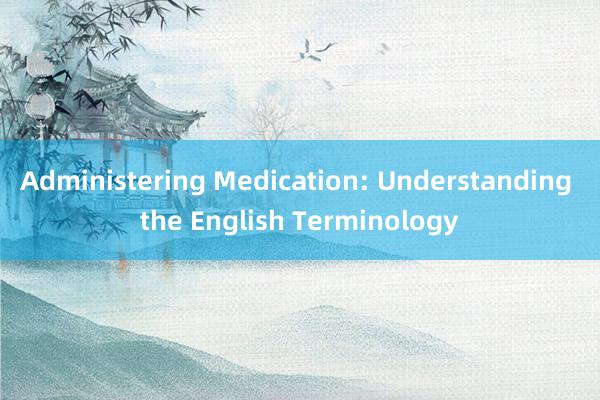Administering Medication: Understanding the English Terminology

### Administering Medication: Understanding the English Terminology
In the medical field, precise communication is crucial to ensure patient safety and effective treatment. This is particularly true when administering medication, where even the slightest misunderstanding can lead to serious consequences. Understanding the English terminology related to medication administration is therefore essential for healthcare professionals around the world. In this article, we delve into some key terms and their significance in the context of medication management.
#### 1. **Dosage Form**
- **Tablet**: A solid dosage form that can be swallowed whole or broken.
- **Capsule**: A solid dosage form that typically contains a powder or liquid within a shell made of gelatin or another material.
- **Liquid**: A dosage form that comes in various concentrations, suitable for patients who cannot swallow pills.
北京华辰科创网络科技有限公司- **Injection**: A medication administered directly into the body through a needle, which can be subcutaneous, 首页-汉嘉艾颜料有限公司 intramuscular, 策勒县实艾传感器有限公司 or intravenous.
#### 2. **Route of Administration**
- **Oral (PO)**: The most common route,梦想超越网个人开发测试 involving swallowing medication.
- **Subcutaneous (SC)**: Injected under the skin’s surface.
- **Intramuscular (IM)**: Injected into a muscle.
- **Intravenous (IV)**: Administered directly into a vein, often for rapid effect or in critical situations.
- **Inhalation (吸入)**: Medication delivered through the mouth or nose.
#### 3. **Frequency**
- **Once daily (qd)**: Taken once per day.
- **Twice daily (bid)**: Taken twice a day.
- **Three times daily (tid)**: Taken three times a day.
- **Four times daily (qid)**: Taken four times a day.
- **As needed (prn)**: Taken when symptoms occur, not at fixed intervals.
#### 4. **Special Instructions**
- **With food (with meals)**: Indicates that the medication should be taken with a meal.
- **Without food (on an empty stomach)**: Suggests taking the medication before eating anything.
- **With plenty of water**: Requires drinking water along with the medication.
- **Rinse mouth**: Indicates that the patient should rinse their mouth after taking certain medications to prevent damage to the throat or teeth.
#### 5. **Contraindications and Precautions**
- **Allergy**: A patient has an allergy to a specific medication or ingredient.
- **Pregnancy**: Medications that are contraindicated during pregnancy.
- **Kidney or liver function**: Adjustments in dosage based on the patient’s organ function.
- **Age**: Some medications may have different dosages or contraindications based on age.
Understanding these terms and their implications is fundamental in ensuring accurate and safe medication administration. Miscommunication in any aspect of medication management can lead to adverse effects个人开发测试, including allergic reactions, incorrect dosing, or interactions with other medications. Therefore, healthcare providers must be proficient in the English terminology related to medication administration to provide high-quality care and maintain patient safety.